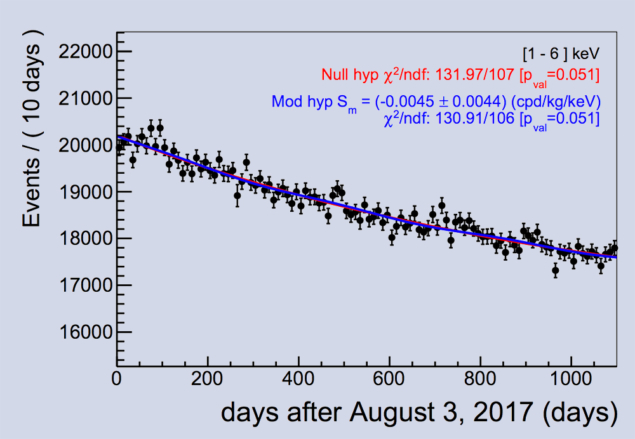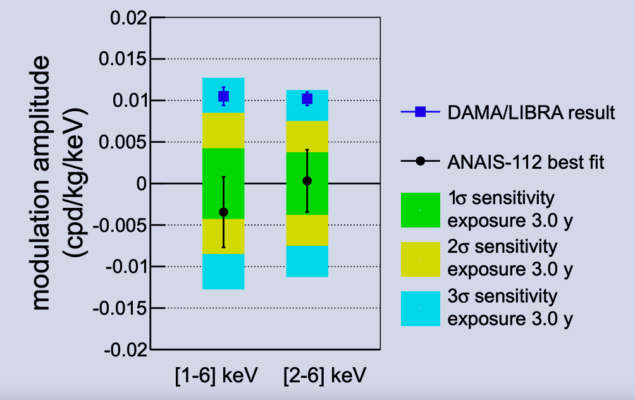
Despite the strong indirect evidence for the existence of dark matter, a plethora of direct searches have not resulted in a positive detection. The exception to this are the famous results from the DAMA/NaI experiment at Gran Sasso underground laboratory in Italy, first reported in the late 1990s, which show a modulating signal compatible with Earth moving through a region containing Weakly Interacting Massive Particles (WIMPs). These results were backed-up more recently with measurements from the follow-up DAMA/LIBRA detector. Combining the data in 2018, the evidence reported for a dark-matter signal is as high as 13 sigma.Now, the Annual modulation with NaI Scintillators (ANAIS) collaboration, which aims to directly reproduce the DAMA results using the same detector concept, has published the results from their first three years of operations. The results, which were presented today at Rencontres de Moriond, show a clear contradiction with DAMA, indicating that we are still no closer to finding dark matter.
The DAMA results are based on searches for an annual modulation in the interaction rate of WIMPs in a detector comprising NaI crystals. First theoretically proposed in 1986 by Andrzej Drukier, Katherine Freese and David Spergel, this modulation is a result of the difference in velocity of Earth with respect to the dark-matter halo of the galaxy. On 2 June, the velocities of Earth and the Sun are aligned with respect to the galaxy, whereas half a year later they are oppositely aligned, resulting in a lower cross section for WIMPs with a detector placed on Earth. Although this method has advantages compared to more direct detection methods, it requires that other potential sources of such a seasonal modulation be ruled out. Despite the significant modulation with the correct phase observed by DAMA, its results were not immediately accepted as a clear signal of dark matter due to the remaining possibility of instrumental effects, seasonal background modulation or artifacts from the analysis.
Over the years the significance of the DAMA results has continued to increase while other dark-matter searches, in particular with the XENON1T and LUX experiments, found no evidence of WIMPs capable of explaining the DAMA results. The fact that only the final analysis products from DAMA have been made public has also hampered attempts to prove or disprove alternative origins of the modulation. To overcome this, the ANAIS collaboration set out to reproduce the data with an independent detector intentionally similar to DAMA, consisting of NaI(Tl) scintillators readout by photomultipliers placed in the Canfranc Underground Laboratory deep beneath the Pyrenees in northern Spain. Using this method ANAIS can rule out any instrument-induced effects while producing data in a controlled way and studying it in detail with different analysis procedures.
The ANAIS results agree with the first results published by the COSINE-100 collaboration

The first three years of ANAIS data have now been unblinded, and the results were posted on arXiv on 1 March. None of the analysis methods used show any signs of a modulation, with a statistical analysis ruling out the DAMA results at 99% confidence. The results therefore narrow down the possible causes of the modulation observed by DAMA to either differences in the detector compared to ANAIS, or in the analysis method. One specific issue raised by the ANAIS collaboration regards the background-subtraction method. In the DAMA results the mean background rate for each year is subtracted from the raw data for that full year. In case the background during that year is not constant, however, this will produce an artificial saw-tooth shape which, with the limited statistics, can be fitted with a sinusoidal. This effect was already pointed out in a publication by a group from INFN in 2020, which showed how a slowly increasing background is capable of producing the exact modulation observed by DAMA. The ANAIS collaboration describes their background in detail, shows that it is indeed not constant, and provides suggestions for a more robust handling of the background.
The ANAIS results also agree with the first results published by the COSINE-100 collaboration in 2019 which, again using a NaI-based detector, found no evidence of a yearly modulation. Thanks to the continued experimental efforts of these two groups, and with the ANAIS collaboration planning to make their data public to allow independent analyses, the more than 20 year-old DAMA anomaly looks likely to be settled in the next few years.
Further reading
J Amaré et al. 2021 arXiv:2103.01175.
D Buttazzo et al. 2020 JHEP 04 137.
COSINE-100 Collab. 2018 Nature 564 83.








